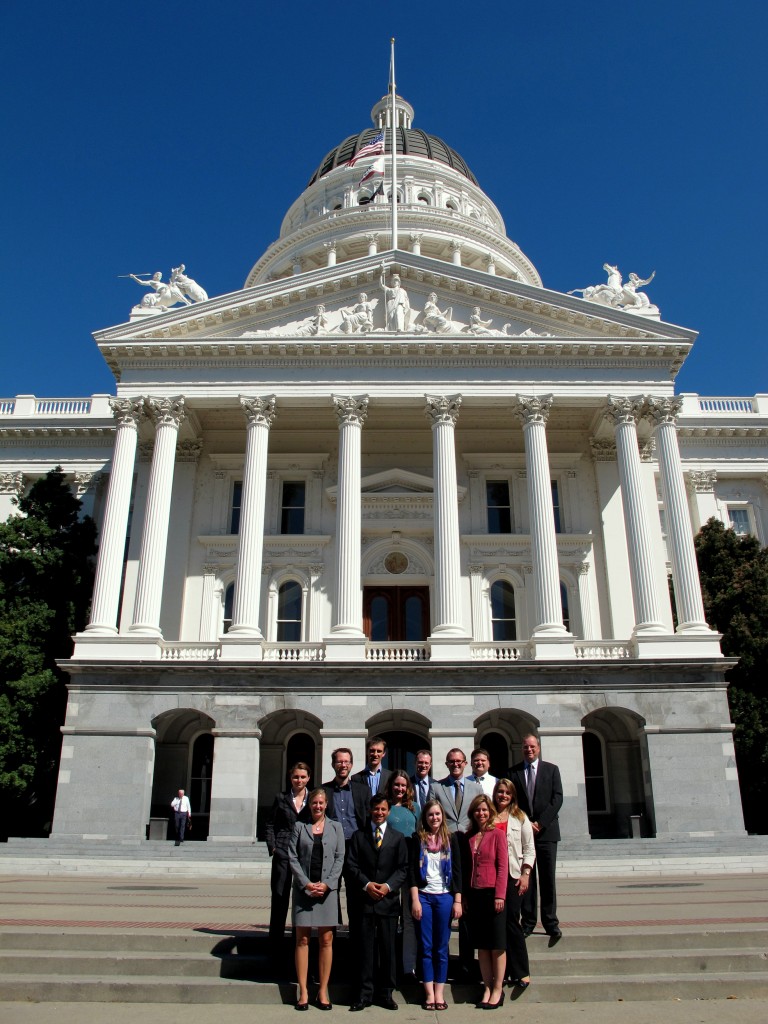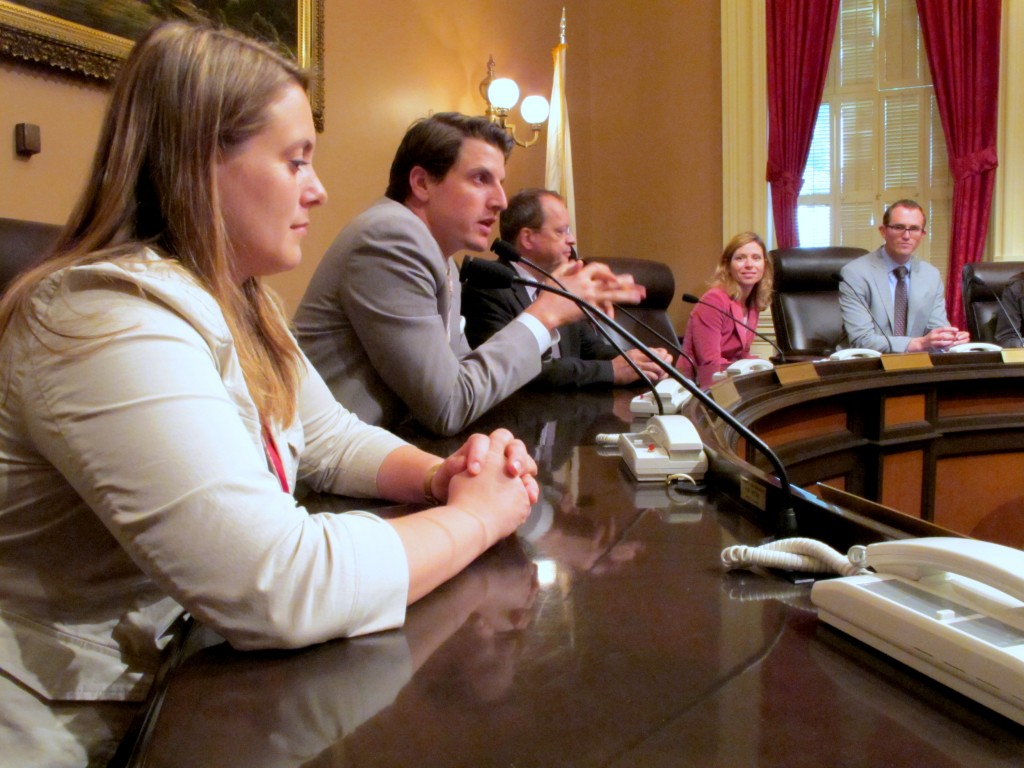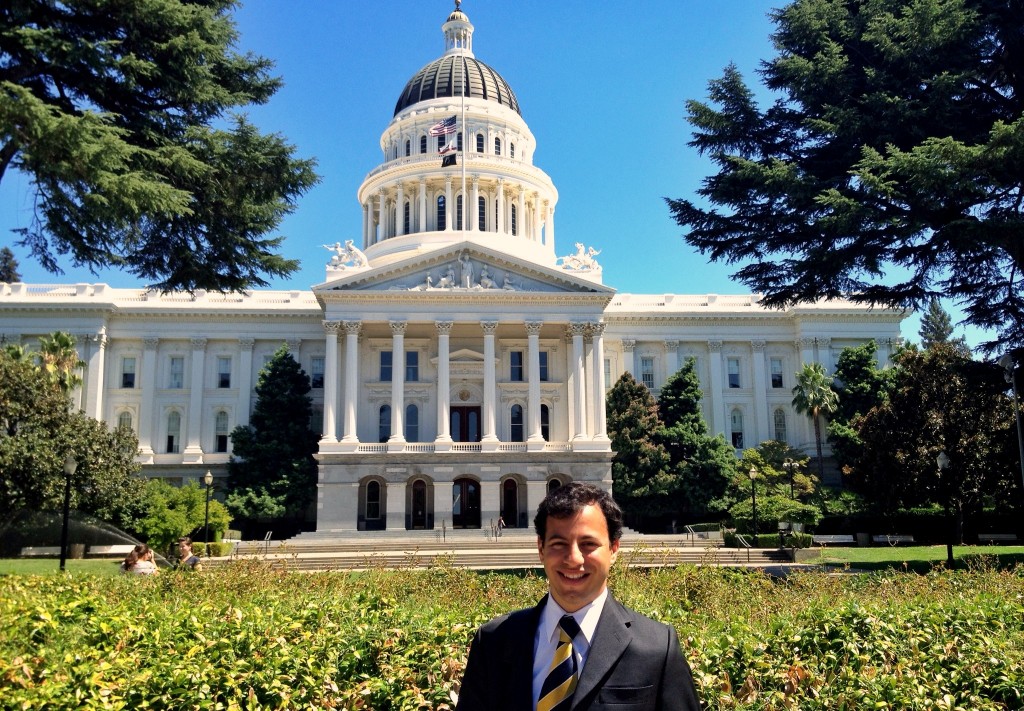EGU’s Science Communications Fellow, Edvard Glücksman, continues to share his thoughts as he takes part in a study tour with other members of the Emerging Leaders in Environmental and Energy Policy Network (ELEEP), a joint project of the Atlantic Council of the United States and the Ecologic Institute. If you have any questions or comments, please contact Ed by email.
With the riches of Colorado’s energy economy still fresh in our minds, we visited the towering California State Capitol in Sacramento to participate in a roundtable discussion on the Golden State’s energy and environmental policy.
The meeting, chaired by Henry Stern, Principal Consultant in Energy & Environmental Policy to State Senator Fran Pavley (D – Agoura Hills), was arranged especially for ELEEP, bringing us together with experts and stakeholders to tease out some of the state’s most important current energy challenges.
Fracking
Like in Colorado, hydraulic fracturing, or fracking, is one of the most pressing points on California’s energy and environment agenda. Two recently proposed bills to make fracking procedures more transparent have recently been rejected by the California Senate. The first, pushed by Senator Pavley, would have required oil companies to give notice to landowners whose property is on or near a potential site, as well as to local governments and water boards, prior to a fracking operation. The lack of disclosure by oil companies became apparent in California in 2011, when local communities in the County of Santa Barbara found out only after the act that Venoco Inc. was fracking in their vicinity.
The second shelved Senate bill would have placed a moratorium on fracking across the state because of concerns about its potential environmental and public health hazards. Generally, Democrats supported the measures whereas Republicans opposed them, the latter backed by the energy industry, which claims oil companies have used fracking in California for decades without incident.
In our discussion, the stakeholders agreed that decisions regarding Northern California’s fracking future are imminent: if legislation fails to either suspend fracking or to make procedures more transparent, the area will soon be considered as “ripe for the picking” by oil and gas companies, with potentially drastic environmental consequences.
Fracking legislation is a hot topic across the US, not least in North Carolina where, in a remarkable vote earlier this year, Republicans overrode a Democratic veto of a fracking bill under highly controversial circumstances: Rep. Becky Carney (D – Mecklenburg County) opposed fracking but pushed the wrong button on the ballot casting machine, voting instead to override the veto and thus giving her opponents a one-vote margin of victory.
Henry Stern (second from left), Principal Consultant in Energy & Environmental Policy to Senator Fran Pavley, leads the roundtable discussion. (Source: Edvard Glücksman)
Net energy metering (NEM)
Net energy metering (NEM), also in place in 43 other US states, is another major discussion point on California’s energy horizon. The state’s NEM programme allows customers who install small solar, wind, biogas, or fuel cell generation facilities (<1 MW) to pay only for the net amount of electricity they take from their energy supplier; in other words, what is above the amount of electricity generated by their home system. Customers thus receive financial credit, used to offset their electricity bill, for power generated by their onsite system and fed back to the utility.
California established its NEM programme in 1995 and, although it has made the state the nation’s solar power leader, the project has caused considerable controversy. One point of contention pertains to whether there should be a legal cap on how much of the total generating capacity can be made available to customers for net metering, currently at 5% of aggregate customer peak demand.
Interestingly, as was explained to us by Sue Kately, Chief Consultant at the California State Assembly Utilities and Commerce Committee, Californian law originally did not specify how utility companies should calculate total generating capacity and, therefore, they tended to use a more restrictive methodology, resulting in an allowance of almost half the amount of net metered renewable energy currently allowed.
Kately also highlighted for us some of the challenges inherent in the NEM approach, not least issues of fairness across the energy grid: while some customers may not be paying their fair share for services they receive from the grid, others may not receive the value of the power they are supplying. She also explained an interesting behavioural shift amongst energy customers: whereas NEM is supposed to reduce peak energy demand by feeding energy into the system during peak times, peak times are shifting to later in the day (4-7 pm), when photovoltaic input is at 50% or less. Finally, she also highlighted some of the issues that arise from having so many different utility companies (California has over 90), all of which contribute to lowering the potential efficacy of NEM programmes.
Despite complications, Stern and the rest of the panel agreed that solar is “here to stay”, despite peaks and crashes inherent in the industry, and that those opposed to it, as well as policy makers, should remain patient and supportive into the future.
A statue entitled ‘Columbus’ Last Appeal to Queen Isabella’ graces the foyer of the California State Capitol (Credit: Edvard Glücksman)
Carbon cap-and-trade programme
We visited California at a pivotal moment, as the state anticipates becoming the nation’s first comprehensive carbon cap-and-trade programme. This would be the first time the market will set a price on carbon, rewarding efficiency and penalising high greenhouse gas emissions.
Under such an arrangement, the state of California would distribute annual carbon allowances to industrial entities that emit large volumes of greenhouse gases, including power plants, oil refineries, factories, and, from 2015, distributors of transportation fuels. The state would set a limit on the amount of greenhouse gases each affected entity is allowed to emit: companies that reduce their emissions below their cap can sell, or ‘trade’, their unused allowances to companies that exceed their limits.
Questions still remain about how to initially hand out the carbon allowances and whether to charge for them or not. An online auction, scheduled for November 14 this year, will allow the over 150 major Californian emitters to bid for a share of the total carbon allowance. However, California’s oil refiners remain keen to start the scheme by having the allowances given away for free.
“The rubber is about to meet the road,” explains Stern, in what could be an historic opportunity for California to take a lead on a matter with serious environmental consequences. Despite the auction date set and a trial auction scheduled for later today, Stern is fearful that high pressure from industry to cancel or modify the agreement may still put a damper on the programme’s development, which could generate as much as $10 billion for the state in a time of fiscal hurt.
As November approaches, the eyes of the world will be on California and Stern knows that a failure to implement what would be a pioneering project would have devastating political and environmental consequences. “The reputation of our budget and of the state are riding on this moment,” he professes. Stay tuned.
By Edvard Glücksman






Pingback: GeoLog | Transformation of the Energy Economy: The US experience – Part VI, California and the future of global energy